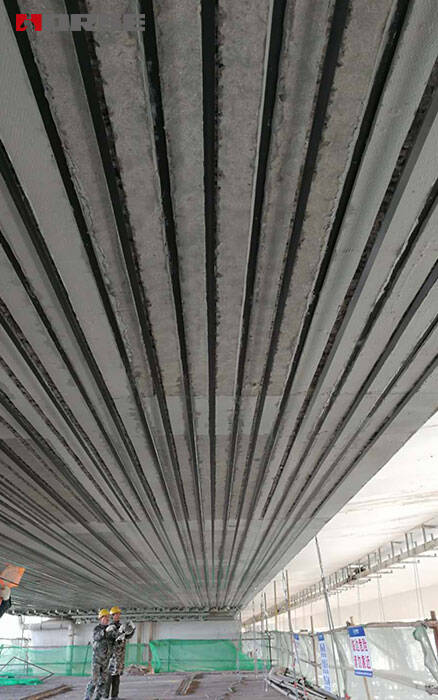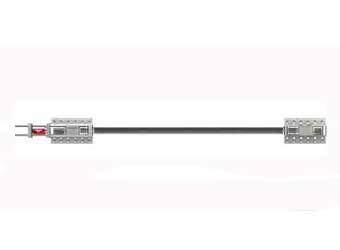Solutions
Horse Construction offers full range of structural strengthening materials with technical supports, documentation supports, products supports, project supports.
With the rapid development of economy and the rapid development of civil engineering, the market demand of FRP materials will be increasing.

Because different fibers have different chemical compositions, the performance of their characteristics is different. The common FRP materials such as glass fiber, carbon fiber, aramid fiber in practical applications also have different characteristics.
(1) tensile and ductility.
Compared with steel bar, this FRP material has more obvious tensile resistance, strength than steel 50 times stronger, the use of FRP material in reducing weight has a more obvious effect. According to the relevant research reports can be seen that FRP tensile strength in the range of tensile strength, there will be no obvious deformation, there will be no bad ductility of the situation, so we can know that FRP material in the tensile strength is relatively strong, ductility is poor.
(2) corrosion resistance and durability
FRP material is more corrosion-resistant than steel, can withstand a variety of acid, alkali and other environments on its corrosion, good resistance to chemical corrosion. In contrast, the traditional civil engineering materials have poor corrosion resistance, are vulnerable to various chemical erosion, is not conducive to the improvement of structural life, and the cost of structural maintenance is relatively high. Especially in the highly corrosive state, it is easier to shorten the life cycle of the structure. FRP material has many advantages in this respect, and has a unique effect on the maintenance of engineering structure quality.
(3) self respect
Because the density of FRP material is far less than the density of steel, it is suitable for various construction conditions and environments. Therefore, in civil engineering construction, in order to reduce labor costs and labor intensity, generally speaking, are using this material. It can ensure the quality of the project, reduce the cost of the project, and in the old building reinforcement, the advantages of using FRP materials are more prominent.
(4) thermal expansion coefficient and elastic aspect
FRP materials need to be mixed with concrete in civil engineering construction, because the thermal expansion coefficient between the two is close, there will not be a relatively large temperature difference, easy to solidify the mixture, after solidification, there will be no cracks due to the internal temperature difference. At the same time, FRP material has smaller elastic modulus compared with steel bar.
(5) other aspects
FRP material also has some shortcomings. Because of its more production and processing procedures, the price is high. At the same time, the material is not good enough in fire resistance, vertical fiber strength and elastic mold. Although the product has obvious advantages such as insulation, heat insulation, etc., but often can not play a role in every occasion.

FRP material is used by various types of civil engineering projects because of its unique advantages, which makes the application of materials gradually increase.
(1) construction works
FRP materials have been used in construction engineering since 1986. With the development of construction industry, the requirements of performance design and material performance have been raised for modern construction engineering. In the process of Engineering construction, it is generally used in the design of engineering structure frame to improve the performance of buildings.
(2) geotechnical engineering
FRP materials have good corrosion resistance, can resist the erosion of chemical substances in various chemical environments, and play a protective role on the structure, so this kind of material is used in reinforced soil. Generally speaking, the shield method is adopted in the tunneling method for the construction units which use this kind of material for engineering construction, because if the traditional method is used for tunneling, the material is easy to be cut off, so the shield method is adopted. Retaining wall, foundation anchor and so on are generally constructed with glass fiber composite material, because this material is low cost, easy to install, durable to meet the quality requirements of these projects.
(3) Bridge Engineering
FRP composites have been used in bridge engineering since the 1970s. Generally, FRP composites are used in cables, prestressing tendons and the whole bridge system. Using this material in old bridge reinforcement can reduce the cost of processing, construction is more convenient, and the interval of reinforcing later will be significantly increased, so that the bending resistance of the bridge has been improved and the service life of the bridge has been increased.

Summary
With the rapid development of economy and the rapid development of civil engineering, the market demand of FRP materials will be increasing. The technical level of FRP materials will be greatly improved, the industrialization process will be gradually accelerated, and applied to all aspects of civil engineering, which will bring enormous economic benefits, social benefits will also be improved. In order to make better use of this new material, the relevant research units also need to make in-depth study on the performance improvement of the material.
You can find anything here you are in need of, have a trust trying on these products, you will find the big difference after that.

High strength, unidirectional carbon fiber wrap pre-saturated to form a carbon fiber reinforced polymer (CFRP) wrap used to strengthen structural concrete elements.

High strength carbon fiber reinforced polymer (CFRP) strip / laminate / plate for structural strengthening and concrete repair

Prestressed carbon fiber reinforced polymer(CFRP) plate for slab, beam strengthening to increase stiffness, reduce distortion and deflection of members, reduce the cracks, avoid and stop cracking.